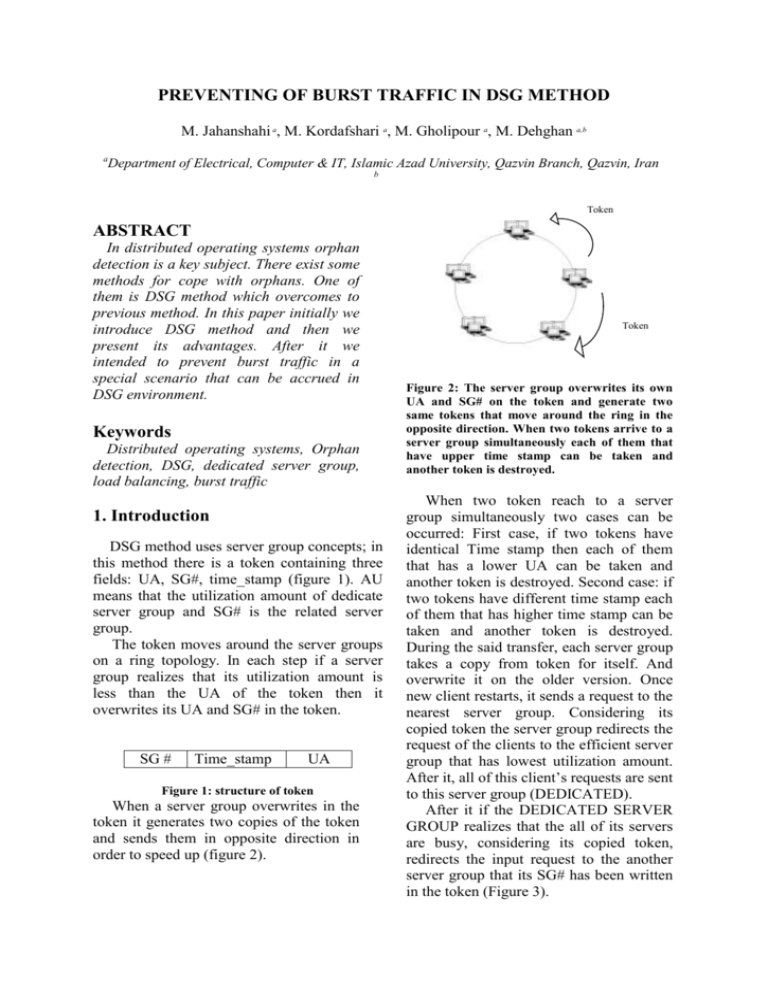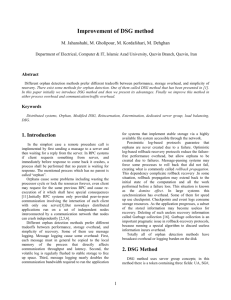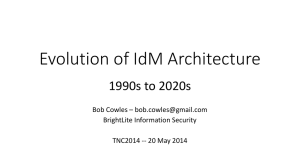497-452
advertisement

PREVENTING OF BURST TRAFFIC IN DSG METHOD M. Jahanshahi a, M. Kordafshari a, M. Gholipour a, M. Dehghan a,b a Department of Electrical, Computer & IT, Islamic Azad University, Qazvin Branch, Qazvin, Iran b Token ABSTRACT In distributed operating systems orphan detection is a key subject. There exist some methods for cope with orphans. One of them is DSG method which overcomes to previous method. In this paper initially we introduce DSG method and then we present its advantages. After it we intended to prevent burst traffic in a special scenario that can be accrued in DSG environment. Keywords Distributed operating systems, Orphan detection, DSG, dedicated server group, load balancing, burst traffic 1. Introduction DSG method uses server group concepts; in this method there is a token containing three fields: UA, SG#, time_stamp (figure 1). AU means that the utilization amount of dedicate server group and SG# is the related server group. The token moves around the server groups on a ring topology. In each step if a server group realizes that its utilization amount is less than the UA of the token then it overwrites its UA and SG# in the token. SG # Time_stamp UA Figure 1: structure of token When a server group overwrites in the token it generates two copies of the token and sends them in opposite direction in order to speed up (figure 2). Token Figure 2: The server group overwrites its own UA and SG# on the token and generate two same tokens that move around the ring in the opposite direction. When two tokens arrive to a server group simultaneously each of them that have upper time stamp can be taken and another token is destroyed. When two token reach to a server group simultaneously two cases can be occurred: First case, if two tokens have identical Time stamp then each of them that has a lower UA can be taken and another token is destroyed. Second case: if two tokens have different time stamp each of them that has higher time stamp can be taken and another token is destroyed. During the said transfer, each server group takes a copy from token for itself. And overwrite it on the older version. Once new client restarts, it sends a request to the nearest server group. Considering its copied token the server group redirects the request of the clients to the efficient server group that has lowest utilization amount. After it, all of this client’s requests are sent to this server group (DEDICATED). After it if the DEDICATED SERVER GROUP realizes that the all of its servers are busy, considering its copied token, redirects the input request to the another server group that its SG# has been written in the token (Figure 3). Comparison between DSG and Reincarnation methods 2 (Redirect) 1(Request) Number of exchanged messages 1200 1000 1000 900 800 800 700 600 600 500 400 400 300 200 100 50 50 50 50 50 50 50 50 50 50 200 0 1 2 3 4 5 6 7 8 9 Minimum of exchanged messages in reincarnation method Maximum of exchanged messages in DSG method 10 Numbe of servers (Scale=1/100) 3 (Dedicate) Figure 4: Comparison between DSG and Reincarnation methods Figure 3: Client sends the RPC request to DEDICATED SERVER GROUP and considering its copied token the server group redirects RPC request to perfect server. After it, all of requests of that client are sent to both DEDICATED SERVER GROUP and second server group (back up). Next time after that all requests to the second server group have been responded, the dedicated server group may select a different server group. Therefore traffic is distributed in the network. In this method epoch massage sent at most to (2 * N; N is number of servers in each group). The advantage of this method is that it neither logs like Extermination method that causes high cost of logging and memory consumption, nor broadcast to entire of networks like Reincarnation method that causes high traffic. Another advantage of our method is that requests of clients can be redirect to other idled servers adaptively. Figure 4 shows that our method considering the number of messages that must be exchanged between nodes in an environment with N servers in each group is better than reincarnation method. N can be any number. In this chart N is fifty. 2. Advantages of DSG method DSG method neither logs like Extermination method that causes high cost of logging and memory consumption therefore its speed is higher than previous ones, nor broadcast to entire of networks like Reincarnation method that causes high traffic. Another advantage of DSG method is that requests of clients can be redirect to other idled servers adaptively via load balancing. In contrast we list advantage of DSG method as follow: 1. Don’t take any log in opposite of Extermination method 2. Don’t broadcast epoch message to the whole of the network in opposite of Reincarnation method 3. Save the resources 4. Perform load balancing 5. Is a perfect distributed method 6. No need to running the garbage collection algorithm in opposite of message logging protocols 8. There is not exponential roll back in spite of message logging protocols 2. Problem definition Suppose that below scenario has been occurred in DSG environment. As you see in figure 5-a, assume that S1 server group has been dedicated to C0 to C10 and also S2 server group has been dedicated to C11 to C20. Now assume that both of S1 and S2 server groups realize that they are busy simultaneously. So both of these group servers considering their copied token find the S3 as idlest server group in the network and also both of them redirect their traffic to S3. So S3 server group has been busy as soon as possible. In this situation both of S1, S2 should find the a backup and both of them may find a same backup considering their copied token such that the mentioned scenario has been occurred continually. That means the same backup server groups has been selected by different server groups and these backup be busy as soon as possible. After this situation these server groups may select the same BSG (backup Server group) for next step and this situation has been occurred continually. This situation causes burst traffic in the network level. 3. Solving the mentioned problem Idea in this method is that each server group must be backup for one server group in each slice of time only. We explain this method as below: Each backup server group that receives a request from a server group earlier(lamport) can be backup of that server group. Then this backup requests from all server groups in order to find out which server group has the first higher UA as compared with itself. Note that this new backup should doesn’t be backup for each other server group. In the next step the first backup redirect requests of second server group to second backup. We explain this method considering figure 5 as follow: C1 S1 C10 S3 C11 S2 C20 a) both of S1 and S2 server groups realize that they are busy simultaneously. So both of these group servers considering their copied token find the S3 as idlest server group in the network and also both of them redirect their traffic to S3 C1 S1 C10 S3 C11 S2 C20 S4 b) S4 server group is the perfect server group. So S3 redirects the S2 traffic to the S4 C1 S1 C10 S3 C11 S2 C20 S4 c) Clients with numbers C1 to C10 and clients with numbers C11 to C20 send their request to both (S1 and S3) and (S2 and S4) respectively Figure 5: Steps of preventing burst traffic in DSG method Initially both of S1 and S2 server groups find the S3 server group as backup. But one of their request reaches to the S3 earlier (lamport). In figure 5-a request of S1 reaches earlier. So S3 has been backup of S1. Then S3 broadcast in the network in order to find out that what server group has first higher UA as compared with itself. Note that this server group must doesn’t be backup of another server group. As you see in figure 5-b S4 server group is the perfect server group. So S3 redirects the S2 traffic to the S4. As you see in figure 5-c , clients with numbers C1 to C10 and clients with numbers C11 to C20 send their request to both (S1 and S3) and (S2 and S4) respectively. 4. Performance Evaluation Since we have n server group in DSG environment therefore origin server group should interacts with n server group. As you see in figure 6, order of finding second backup server group is O(n). 5. Conclusion The probability of occurrence of this scenario in the DSG environment is low. But if this scenario has been occurred, causes server groups have been selected and be busy as soon as possible continually. As you saw, this situation can causes burst traffic in the network Presenting this algorithm causes that DSG method be full distributed more than previous. Also burst traffic has been prevented. Procedure find_out(origin as server group) Begin Request (origin.id, ALL); // Request (Source, Destination) Receive (origin.id, ALL); // Receive (Source, Destinations) Min_Of_All := UA[0] ; // UA[i] means the utilization amount of i th backup server groups MYUA := origin.UA ; For int I := 1 to n-1 DO If ( MYUA < UA[i] < Min_Of_All ) then Min_Of_All := UA[i]; Return (Min_Of_All); End. Figure 6: Algorithm of preventing burst traffic in DSG method References: [1] M. Jahanshahi, K. Mostafavi, M. S. Kordafshari, M. Gholipour, A. T. Haghighat, "Two new approaches for orphan detection", Proc. The IEEE 19th International Conference on Advanced Information Networking and Applications,Taiwan,2005 [2] Maurice P. Herlihy, Martin S. Mckendry, “Timestamp-Based Orphan Elimination”, IEEE transaction on software Engineering, VOL. 15, NO. 7, 1990. [3] L. P. Barreto, I. Jansch-Porto, “Open and Reliable Group Communication”, Proc. Sixth Euromicro Workshop on Parallel and Distributed Processing, Madrid, Spain, 1998, pp. 389-394. [4] V. Issarny, G. Muller, and I. Puaut, “Efficient Treatment of Failures in RPC Systems”, Proc. IEEE Transaction on Computer, 1994, 170-78. [5]A. S. Tanenbaum, Distributed Operating System, Prentice-Hall, 2003. [6]L. Alvisi, K. Marzullo, “Message Logging: Pessimistic, Optimistic”, Causal, and Optimal, Proc. IEEE Transactions on Software Engineering, VOL. 24, NO. 2, 1998. [7] Om P. Damani, Vijay K. garg, “How to Recover Efficiently and Asynchronously When Optimism Fails”, Proc. IEEE Transactions on Software Engineering, VOL. 1063-6927, 1996, 108-114. [8] Alvisi, L. and Marzullo, K., “Non-blocking and orphan-free message logging protocols”, Proc. 23rd IEEE International Symposium on Fault-Tolerant Computing, Toulouse, France, 1993, 145-154. [9] R. Baldoni, J. Brzezinski, J.M. Helary, A. Mostefaoui and M. Raynal, “Characterization of consistent global checkpoints in large-scale distributed systems”, Proc. 5th IEEE Workshop on Future Trends of Distributed Computing Systems, Chenju, Korea, 1995, 314 -323. [10] F. Panzieri, S. K. Shrivastava, “A Remote Procedure Call Mechanism Supporting Orphan Detection and Killing”, Proc. IEEE Transaction On Software Engineering, VOL.14, NO.1, 1988. [11] Shiva, S. Virmani, R., “Implementation of reliable and efficient Remote Procedure Calls”, Proc. IEEE, 1993 , Charlotte, NC, USA, On page(s): 5p. [12] K. Ranvindran, S. Chanson, “Failure Transparency in Remote Procedure Calls”, Proc. IEEE Transaction on Computer, VOL. 38, NO. 8, 1989. [13] A. K.Ezzat, “Orphan Elimination in Distributed Object-Oriented Systems, Proc. Second IEEE Workshop on Future Trends Distributed Computing Systems, Cairo, Egypt, 1990, pp. 403-412. [14] B. Yao, W. Fuchs, ”Message Logging Optimization for Wireless Networks”, Proc. 20th IEEE Symposium on Reliable Distributed Systems, 2001, pp. 0182. [15] S. Pleisch, A. Kupsys and A. Schiper, “Preventing Orphan Requests in the Context of Replicated Invocation”, Proc. IEEE 22nd International Symposium on Reliable Distributed System,2003. [16] E. N. (Mootaz) Elnozahy, L. Alvisi, Yi-Min Wang and D. B. Johnson, “A survey of rollback-recovery protocols in message-passing systems”, Proc. ACM Computing Surveys (CSUR), Vol. 34, Issue 3, 2002, Pages: 375 – 408. [17] Kwang-Sik Chung , Ki-Bom Kim , Chong-Sun hwang ,jin gon Shon and Heon-Chang yu, "Hybrid checkpointing protocol based on selective-sender-based message logging", Proc. International Conference on Parallel and Distributed Systems, 1997, pp. 788 [18] X. Fu, D. Wang, W. Zheng and M. Sheng, "GPRTree : A Global Parallel Index Structure for Multiattribute Declustering on Cluster of workstations", Proc. IEEE Transaction on Computer , 1997, 788-793






